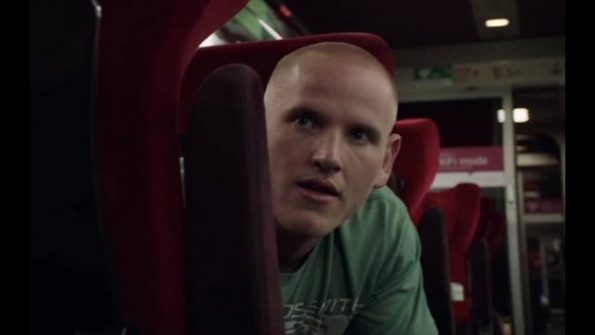The 15:17 to Paris (Eastwood, 2018)
Clint Eastwood puts a new spin on what it means to be cinematic in his latest directed and produced film, The 15:17 to Paris. The movie depicts the real-world 2015 terrorist attack on the Thalys train to Paris, where three Americans—Spencer Stone, Anthony Sadler, and Alek Skarlatos—disarm and bind the attacker while saving the passengers. From the plot description, you might think that this is another entry in the string of drama/action films that Eastwood has done so well in recent years (American Sniper and Sully). But instead of casting high-caliber actors like Bradly Cooper or Tom Hanks to carry the film, Eastwood has the real-life American heroes (and a couple of the real-life victims) play themselves. The movie isn’t just an adventure film because it depicts people thwarting a terrorist gunman on a train. The movie is also an adventure because it blurs the lines between acting and reality.
Eastwood’s vision gives audiences a fresh point of view and a different movie-going experience. Nevertheless, casting “non-actors” holds back the movie from soaring to heights that Eastwood’s films typically reach. Stone’s and Sadler’s mothers are played by Judy Greer and Jenna Fischer, who give the film its best performances. Knowing that novice actors, Stone and Sadler, would pale in comparison to Greer and Fischer, Eastwood limits the scenes in which the “real” people interact with the actors to one scene each between the men and their mothers. In each of these scenes, the audience realizes that acting is a skill that people have (or don’t have). When Stone tells his mom, Greer, that he’s unable to pursue the job he wants in the military, it’s the actor Greer who seems the most real and the “real” person Stone comes across like cardboard. Similarly, when Fischer drops Sadler off at the airport to begin active duty, she delivers a nuanced performance of joy, sadness, uncertainty, and—surprisingly—prophecy, while Sadler slips away as soon as the scene allows.
Yet while in these scenes the actors clearly outshine (and out-real) the men portraying themselves, these scenes also can withstand such awkwardness because Eastwood has masterfully identified where best to play off the raw inexperience of the real mean. It’s believable that a young man is awkward when opening up to his mother, and realistically, in these scenes, the mothers would do most of the openhearted talking. Limiting the number of scenes, keeping them brief, staging them around painful experiences—all of these techniques showcase the expertise of Eastwood mitigating the inexperience of the real-life actors as much as possible
The movie spends a lot of its time depicting the men’s travels through Europe. It feels as if someone videotaped their backpacking experience. On one hand, the scenes are masterfully done: the authenticity is impressive. Still, it’s boring to watch someone else’s vacation, and the movie drags considerably during this portion. Nonetheless, here Eastwood establishes the men as ordinary young guys, which is essential to the movie’s theme. When they board the train, that’s what viewers see: American kids—not heroes—making their way for fun in Paris.
Viewers get snippets of the train throughout the movie: brief moments of people screaming and running for their lives. These flashes not only give a welcomed reprieve from the European travels but also build the climax, making the rather short scene on the train more impactful. It also nods to the fact that viewers know what will happen; it won’t come as a surprise, and therefore, Eastwood has to build suspense using other tactics.
The train scene comes, and we are plunged into the extraordinary event that Sadler’s mother predicted with faithful hope. And yet what hope can be found in the midst of a terrorist attack? Confusion, chaos, screams—people fleeing with nowhere to go. One man who tried to figure out what was happening gets shot (the man portrayed by the real-life victim, incidentally). And then, the protagonists jump into action. Fearlessly, the three men charge the terrorist, knock him unconscious, tend the shot man’s wound, and pacify the other passengers.
As in all his films, Eastwood conveys his message clearly: when there’s a time to act, act. Three young men (granted, two with military experience) made this decision and a tragedy was avoided. The movie concludes with Stone reciting a prayer he’s prayed since his childhood, asking God to make him, “an instrument of Your peace.” The movie asks its audience if when faced with terror and the threat of death, will they find the determination to be an instrument of peace and example of bravery?
Eastwood does something rare and interesting by having the men play themselves. He demonstrates his skill as a director and provides an uplifting message which manages to empower the viewer with a message of hope in ordinary people in these days of uncertainty and terrorism. Still, the movie isn’t extremely entertaining, and the characters aren’t exactly riveting. In the end, the experiment of blurring the lines between cinema and reality rendered mixed results. The director’s skill made it watchable but I am not sure I wanted to see more examples of its casting gimmick.

